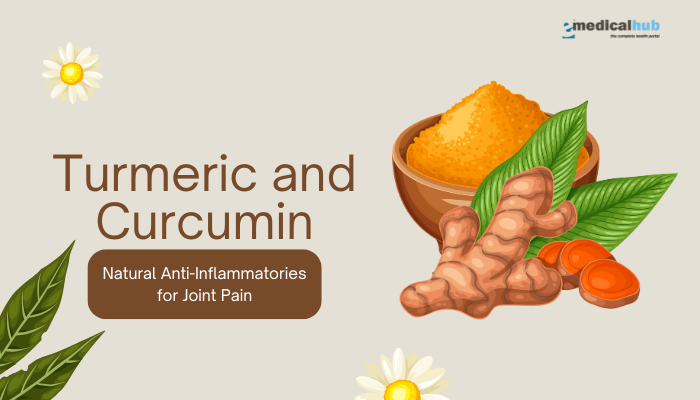Introduction
Chronic joint pain affects millions of people worldwide and can significantly reduce quality of life. Many seek natural solutions to manage inflammation and ease discomfort. Turmeric, a vibrant yellow spice long used in traditional medicine, contains curcumin—its active compound known for powerful anti-inflammatory properties.
Research suggests that curcumin may reduce inflammation in joints, potentially easing pain associated with conditions like arthritis. This article explains the science behind turmeric and curcumin, reviews the clinical evidence supporting their use for joint pain, and provides practical guidance on how to incorporate these natural anti-inflammatories into your wellness routine.
Disclaimer: This article is for educational purposes only and does not substitute for professional medical advice. If you suffer from chronic joint pain or have a medical condition, please consult a qualified healthcare provider before starting any new treatment.
Understanding Turmeric and Curcumin
What Is Turmeric?
- Turmeric is a spice derived from the root of the Curcuma longa plant.
- It is widely used in cooking and traditional medicine, especially in India and Southeast Asia.
- Turmeric’s bright yellow color comes from curcuminoids, a group of compounds that includes curcumin.
What Is Curcumin?
- Curcumin is the primary active component in turmeric.
- It has been studied for its antioxidant, anti-inflammatory, and anti-cancer properties.
- Curcumin is not highly bioavailable on its own; its absorption can be improved with black pepper (piperine) or by using specialized formulations.
Historical Use in Traditional Medicine
- Turmeric has been used for centuries in Ayurvedic and traditional Chinese medicine.
- It is employed to treat digestive disorders, respiratory issues, and joint pain.
- Ancient healers valued turmeric for its ability to “warm” the body, promote circulation, and reduce inflammation.
How Curcumin Works as an Anti-Inflammatory
Mechanisms of Action
Curcumin combats inflammation through several biological pathways:
- Inhibition of Pro-inflammatory Cytokines: Curcumin reduces the production of molecules like tumor necrosis factor-alpha (TNF-α) and interleukin-6 (IL-6).
- Blocking the NF-κB Pathway: NF-κB is a protein complex that plays a central role in regulating inflammation. Curcumin inhibits its activation, thereby lowering inflammation.
- Antioxidant Effects: Curcumin scavenges free radicals, reducing oxidative stress that can trigger inflammatory responses.
- Modulating Enzymes: It decreases the activity of enzymes such as cyclooxygenase-2 (COX-2), which are involved in the inflammatory process.
Impact on Joint Health
- Arthritis Relief: By lowering inflammation, curcumin may help reduce pain and swelling in joints, particularly in osteoarthritis and rheumatoid arthritis.
- Improved Mobility: Less inflammation leads to less stiffness, which can improve joint mobility and overall function.
- Protection of Cartilage: Curcumin may slow the degradation of cartilage by reducing inflammatory markers that lead to joint deterioration.
Scientific Evidence Supporting Turmeric and Curcumin for Joint Pain
Clinical Studies and Meta-Analyses
Several clinical trials and systematic reviews have evaluated the benefits of curcumin for joint pain:
- Osteoarthritis Studies: Research has shown that curcumin supplements can reduce pain and improve joint function in osteoarthritis patients. Some studies report that curcumin performs similarly to nonsteroidal anti-inflammatory drugs (NSAIDs) without the gastrointestinal side effects.
- Rheumatoid Arthritis Research: Trials on patients with rheumatoid arthritis have noted reductions in inflammatory markers and pain scores when using curcumin as an adjunct to conventional therapy.
- Meta-Analyses: Systematic reviews have generally found that curcumin significantly reduces pain and improves function compared to placebo, though study quality and curcumin formulations vary.
Limitations in the Research
- Bioavailability Issues: Many studies use enhanced formulations of curcumin to overcome its low natural bioavailability. Not all turmeric supplements provide sufficient levels of active curcumin.
- Study Heterogeneity: Variations in dosage, treatment duration, and patient populations make it difficult to standardize recommendations.
- Placebo Effects: Some improvements might be partially attributed to the placebo effect, common in studies of pain management.
How to Use Turmeric and Curcumin for Joint Pain
Forms of Consumption
There are several ways to incorporate turmeric and curcumin into your routine:
- Turmeric Spice: Use turmeric powder in cooking. Combine with black pepper to enhance curcumin absorption.
- Curcumin Supplements: Capsules or tablets with standardized doses of curcumin are convenient for consistent dosing.
- Liquid Extracts and Tinctures: These can be added to water or smoothies for a quick dose.
- Golden Milk: warm beverage made with turmeric, milk (or plant-based milk), black pepper, and other spices like ginger.
Recommended Dosage
- Curcumin Supplements: Clinical trials often use dosages ranging from 500 mg to 2,000 mg per day of a bioavailable formulation.
- Turmeric in Cooking: While it is difficult to measure curcumin content in food, regular use of turmeric in your diet can contribute to overall anti-inflammatory benefits.
Enhancing Absorption
- Black Pepper (Piperine): Adding a pinch of black pepper can increase curcumin absorption by up to 2,000%.
- Healthy Fats: Curcumin is fat-soluble. Consuming it with a source of healthy fat (e.g., coconut oil or olive oil) improves its bioavailability.
- Specialized Formulations: Some supplements use nanoparticles, liposomal delivery systems, or phytosomes to boost absorption.
Practical Tips for Incorporating Turmeric into Your Daily Routine
Dietary Strategies
- Cooking with Turmeric: Add turmeric to soups, stews, rice dishes, and curries. Its warm flavor pairs well with a variety of cuisines.
- Smoothies and Golden Milk: Blend turmeric with fruits and vegetables or enjoy it as a soothing warm beverage.
- Daily Supplements: If you choose supplements, take them with meals containing fat and black pepper to maximize absorption.
Lifestyle Modifications
- Combine with Anti-Inflammatory Diet: Incorporate other anti-inflammatory foods such as ginger, omega-3 fatty acids, leafy greens, and nuts to support joint health.
- Regular Exercise: Low-impact activities like swimming, yoga, and walking can complement the anti-inflammatory effects of curcumin by reducing joint stiffness.
- Stress Management: Techniques such as meditation, deep breathing, and adequate sleep also play a role in reducing inflammation and supporting overall joint health.
Monitoring Your Progress
- Track Pain Levels: Keep a daily log of joint pain, stiffness, and overall mobility to gauge the impact of turmeric and curcumin over time.
- Adjust Dosage as Needed: If you do not notice improvements after several weeks, consult your healthcare provider to adjust the dosage or explore alternative formulations.
- Combine Therapies: Use turmeric alongside other treatments (physical therapy, medications) as advised by your healthcare professional for optimal results.
Potential Side Effects and Considerations
Common Side Effects
- Gastrointestinal Discomfort: High doses of curcumin can cause stomach upset or diarrhea.
- Allergic Reactions: Rarely, individuals may experience allergic reactions to turmeric.
- Staining: Turmeric can stain clothing and surfaces; handle it carefully in the kitchen.
Drug Interactions
- Blood Thinners: Turmeric may enhance the effects of anticoagulant medications.
- Diabetes Medications: It may lower blood sugar levels, so monitoring is necessary when taken with diabetic drugs.
- Gastrointestinal Medications: Turmeric’s acid-neutralizing effects may interfere with certain drugs.
Special Populations
- Pregnant or Nursing Women: Consult a healthcare provider before using high-dose turmeric or curcumin supplements.
- Individuals with Gallstones or Bile Duct Obstruction: Turmeric may exacerbate these conditions.
- Surgical Patients: Stop taking turmeric supplements at least 2 weeks before surgery due to its potential blood-thinning effects.
Quality Control
- Reputable Brands: Choose supplements that have undergone third-party testing to ensure purity and potency.
- Standardization: Look for products with standardized curcumin content to guarantee consistent dosing.
- Avoid Contaminants: Ensure that products are free from heavy metals and pesticides.
Scientific Research: A Closer Look
Evidence from Clinical Trials
- Osteoarthritis Relief: Several randomized controlled trials (RCTs) have shown that curcumin supplementation reduces pain and improves joint function in osteoarthritis patients.
- Rheumatoid Arthritis: Some studies report that curcumin, used as an adjunct to conventional therapy, decreases inflammatory markers and improves symptoms.
- Chronic Pain Management: Meta-analyses have concluded that curcumin has a modest but statistically significant effect on reducing pain intensity compared to placebo.
Mechanistic Studies
- Anti-Inflammatory Pathways: Research shows that curcumin downregulates NF-κB and COX-2, key drivers of inflammation.
- Antioxidant Activity: Curcumin’s ability to neutralize free radicals reduces oxidative stress, which contributes to inflammation and joint damage.
- Cellular Repair: Some studies indicate that curcumin may promote the regeneration of cartilage and support joint health over the long term.
Limitations of Current Research
- Bioavailability: The low natural bioavailability of curcumin is a significant challenge. Enhanced formulations have shown promise but vary in effectiveness.
- Variability in Study Designs: Differences in dosage, treatment duration, and patient populations complicate comparisons across studies.
- Placebo Effects: Some studies note improvements in both the treatment and placebo groups, highlighting the need for further rigorous research.
Integrating Turmeric into a Comprehensive Joint Pain Management Plan
Combining with Conventional Treatments
- Complementary Therapy: Turmeric should be used to complement, not replace, conventional treatments like NSAIDs, physical therapy, or surgery when necessary.
- Holistic Approach: Pair turmeric with lifestyle modifications, such as weight management, exercise, and a balanced anti-inflammatory diet, for maximum benefit.
- Regular Monitoring: Work with your healthcare provider to monitor joint health and adjust treatments as needed.
Lifestyle and Diet for Joint Health
- Anti-Inflammatory Diet: Emphasize fruits, vegetables, whole grains, omega-3-rich fish, and nuts to further reduce inflammation.
- Physical Activity: Engage in low-impact exercises such as swimming, walking, or yoga to maintain joint mobility without overstraining them.
- Stress Management: Techniques like meditation and deep breathing can reduce overall stress and inflammation.
Practical Strategies for Daily Use
- Morning Routine: Add turmeric to your morning smoothie or warm milk to start the day with an anti-inflammatory boost.
- Cooking: Use turmeric powder in curries, soups, and rice dishes, always paired with black pepper and healthy fats.
- Supplement Regimen: If you opt for supplements, follow dosage instructions carefully and consider enhanced formulations for better absorption.
Frequently Asked Questions (FAQ)
What is the ideal dosage of curcumin for joint pain?
Clinical studies typically use doses ranging from 500 mg to 2,000 mg per day of a bioavailable curcumin formulation. Always consult your healthcare provider for personalized guidance.
How can I improve the absorption of curcumin?
Pair curcumin with black pepper (piperine) and take it with a meal containing healthy fats. Consider using supplements with enhanced bioavailability, such as those with nanoparticles or liposomal delivery.
Can turmeric replace my pain medication?
Turmeric is best used as a complementary therapy. It may help reduce inflammation and pain but should not replace prescribed medications without consulting a doctor.
How long does it take to see improvements in joint pain?
Many users report improvements after 4 to 8 weeks of consistent use, though results can vary based on the severity of the condition and individual response.
Are there any side effects associated with curcumin?
Common side effects may include gastrointestinal discomfort or diarrhea, especially at high doses. It may also interact with medications such as blood thinners.
Is turmeric effective for both osteoarthritis and rheumatoid arthritis?
Research indicates that turmeric may provide benefits for both conditions by reducing inflammation, though the evidence is stronger for osteoarthritis. Always discuss with a healthcare provider.
Can I use turmeric if I’m pregnant or breastfeeding?
Pregnant or breastfeeding women should consult their healthcare provider before using high-dose turmeric supplements, as safety data is limited.
What are the best forms of turmeric to consume?
Turmeric can be consumed as a spice in food, in the form of golden milk, or as standardized curcumin supplements. The choice depends on your preferences and the desired potency.
How does curcumin reduce inflammation?
Curcumin reduces inflammation by inhibiting inflammatory cytokines, blocking the NF-κB pathway, and acting as an antioxidant to neutralize free radicals.
Can I combine turmeric with other anti-inflammatory supplements?
Yes, but consult your healthcare provider to avoid potential interactions or overdosing on similar compounds.
Does turmeric help with joint stiffness as well as pain?
Many users experience reduced joint stiffness and improved mobility, likely due to curcumin’s effects on inflammation and cartilage protection.
Where can I find high-quality curcumin supplements?
Look for products from reputable brands that provide third-party lab testing and clear labeling on curcumin content and bioavailability enhancers like piperine.
Conclusion
Turmeric and its active compound curcumin offer a natural approach to managing joint pain through their potent anti-inflammatory and antioxidant effects. Although the bioavailability of curcumin presents challenges, enhanced formulations and proper consumption techniques can maximize its benefits. Scientific studies show promising results, especially for osteoarthritis and other inflammatory conditions, though it is not a substitute for conventional medical treatment.
When integrated with a healthy lifestyle that includes a balanced anti-inflammatory diet, regular physical activity, and proper medical care, turmeric can serve as an effective complementary therapy for joint pain. As with any supplement, consistency, quality, and professional guidance are key to unlocking its full potential. Whether you choose to add turmeric to your meals or opt for a standardized curcumin supplement, this ancient remedy may help you achieve reduced inflammation, improved mobility, and a better quality of life.
Embrace turmeric as part of a holistic approach to joint health and overall well-being. With careful use and integration into your daily routine, you can harness the natural power of curcumin to support long-term pain relief and vitality.
References
- Aggarwal BB, Harikumar KB. Potential therapeutic effects of curcumin, the anti-inflammatory agent, against neurodegenerative, cardiovascular, pulmonary, metabolic, autoimmune and neoplastic diseases. Int J Biochem Cell Biol. 2009;41(1):40-59.
- Hewlings SJ, Kalman DS. Curcumin: A review of its’ effects on human health. Foods. 2017;6(10):92.
- Daily JW, Yang M, Park S. Efficacy of turmeric extracts and curcumin for alleviating the symptoms of joint arthritis: a systematic review and meta-analysis of randomized clinical trials. J Med Food. 2016;19(8):717-729.
- Belcaro G, Cesarone MR, Dugall M, et al. Efficacy and safety of Meriva®, a curcumin-phosphatidylcholine complex, during extended administration in osteoarthritis patients. Altern Med Rev. 2010;15(4):337-344.
- Chandran B, Goel A. A randomized, pilot study to assess the efficacy and safety of curcumin in patients with active rheumatoid arthritis. Phytother Res. 2012;26(11):1719-1725.
- Wang YJ, Pan MH, Cheng AL, et al. Stability of curcumin in buffer solutions and characterization of its degradation products. J Pharm Biomed Anal. 1997;15(12):1867-1876.
- Panahi Y, Saadat A, Beiraghdar F, et al. Efficacy of curcuminoids in the management of knee osteoarthritis: a randomized controlled trial. Phytother Res. 2014;28(4):579-585.
- Lao CD, et al. Dose escalation of a curcuminoid formulation. BMC Complement Altern Med. 2006;6:10.
- Ammon HP. Modulation of the immune system by curcumin. Prostaglandins Leukot Essent Fatty Acids. 2001;65(2-3):259-269.
- Gupta SC, et al. Multitargeting by curcumin as revealed by molecular interaction studies. Nat Prod Rep. 2011;28(12):1937-1955.
- Kunnumakkara AB, et al. Curcumin, the golden nutraceutical: multitargeting for multiple chronic diseases. Br J Pharmacol. 2017;174(11):1325-1348.
- World Health Organization. Guidelines on Good Agricultural and Collection Practices (GACP) for Medicinal Plants. Geneva: WHO; 2003.




